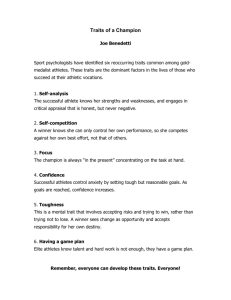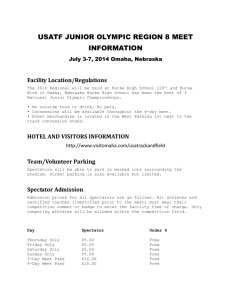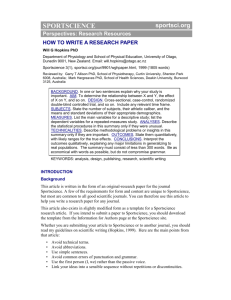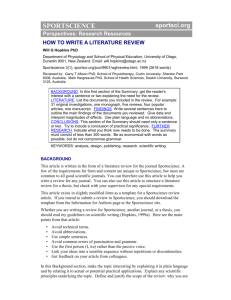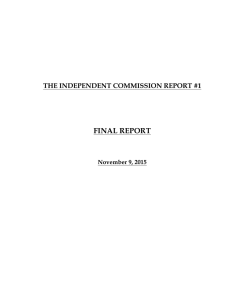Reprint doc - Sportscience
advertisement
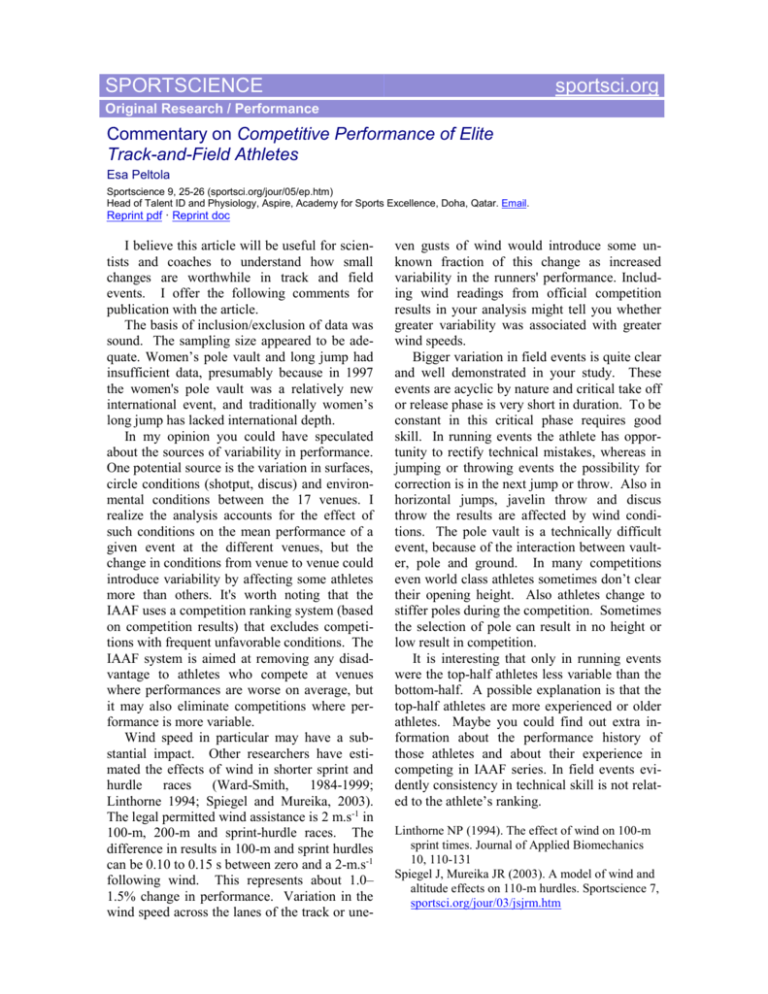
SPORTSCIENCE sportsci.org Original Research / Performance Commentary on Competitive Performance of Elite Track-and-Field Athletes Esa Peltola Sportscience 9, 25-26 (sportsci.org/jour/05/ep.htm) Head of Talent ID and Physiology, Aspire, Academy for Sports Excellence, Doha, Qatar. Email. Reprint pdf · Reprint doc I believe this article will be useful for scientists and coaches to understand how small changes are worthwhile in track and field events. I offer the following comments for publication with the article. The basis of inclusion/exclusion of data was sound. The sampling size appeared to be adequate. Women’s pole vault and long jump had insufficient data, presumably because in 1997 the women's pole vault was a relatively new international event, and traditionally women’s long jump has lacked international depth. In my opinion you could have speculated about the sources of variability in performance. One potential source is the variation in surfaces, circle conditions (shotput, discus) and environmental conditions between the 17 venues. I realize the analysis accounts for the effect of such conditions on the mean performance of a given event at the different venues, but the change in conditions from venue to venue could introduce variability by affecting some athletes more than others. It's worth noting that the IAAF uses a competition ranking system (based on competition results) that excludes competitions with frequent unfavorable conditions. The IAAF system is aimed at removing any disadvantage to athletes who compete at venues where performances are worse on average, but it may also eliminate competitions where performance is more variable. Wind speed in particular may have a substantial impact. Other researchers have estimated the effects of wind in shorter sprint and hurdle races (Ward-Smith, 1984-1999; Linthorne 1994; Spiegel and Mureika, 2003). The legal permitted wind assistance is 2 m.s-1 in 100-m, 200-m and sprint-hurdle races. The difference in results in 100-m and sprint hurdles can be 0.10 to 0.15 s between zero and a 2-m.s-1 following wind. This represents about 1.0– 1.5% change in performance. Variation in the wind speed across the lanes of the track or une- ven gusts of wind would introduce some unknown fraction of this change as increased variability in the runners' performance. Including wind readings from official competition results in your analysis might tell you whether greater variability was associated with greater wind speeds. Bigger variation in field events is quite clear and well demonstrated in your study. These events are acyclic by nature and critical take off or release phase is very short in duration. To be constant in this critical phase requires good skill. In running events the athlete has opportunity to rectify technical mistakes, whereas in jumping or throwing events the possibility for correction is in the next jump or throw. Also in horizontal jumps, javelin throw and discus throw the results are affected by wind conditions. The pole vault is a technically difficult event, because of the interaction between vaulter, pole and ground. In many competitions even world class athletes sometimes don’t clear their opening height. Also athletes change to stiffer poles during the competition. Sometimes the selection of pole can result in no height or low result in competition. It is interesting that only in running events were the top-half athletes less variable than the bottom-half. A possible explanation is that the top-half athletes are more experienced or older athletes. Maybe you could find out extra information about the performance history of those athletes and about their experience in competing in IAAF series. In field events evidently consistency in technical skill is not related to the athlete’s ranking. Linthorne NP (1994). The effect of wind on 100-m sprint times. Journal of Applied Biomechanics 10, 110-131 Spiegel J, Mureika JR (2003). A model of wind and altitude effects on 110-m hurdles. Sportscience 7, sportsci.org/jour/03/jsjrm.htm 26 Ward-Smith AJ (1984). Air resistance and its influence on the biomechanics and energetics of sprinting at sea level and at altitude. Journal of Biomechanics 17, 339-347 Ward-Smith AJ (1985). A mathematical analysis of the influence of adverse and favourable winds on sprinting. Journal of Biomechanics 18, 351-357 Published Dec 2005 ©2005 Ward-Smith AJ (1997). A mathematical analysis of the bioenergetics of hurdling, Journal of Sport Sciences 15, 517-526 Ward-Smith AJ (1999). New insights into the effect of wind assistance on sprinting performance. Journal of Sport Sciences 17, 325-334





